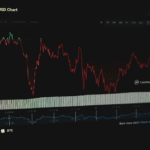The fast-paced world of digital asset exchanges thrives on liquidity, the ease with which traders can buy and sell assets. Algorithmic market making (AMM) steps in, employing automated trading strategies to enhance this vital aspect of the market.
Let’s explore how AMM functions and its impact on liquidity provision.

Market Making on Autopilot
Traditionally, market makers were human experts who quoted bids and asked prices, facilitating trades and ensuring smooth market operations. AMM takes this role a step further, utilizing sophisticated algorithms to analyze market data and submit orders continuously. These algorithms consider factors like order book depth, price trends, and volatility to generate optimal buy and sell orders.
Precision Pricing Models
AMM algorithms rely on robust pricing models to determine the most suitable bid and ask prices. Common models include:
- Mid-Price Model:This sets bids and asks at the average price between the highest buy order (bid) and the lowest sell order (ask) in the order book.
- Inventory-Based Model:This factors in the quantity of an asset the market maker holds, adjusting prices to maintain a desired inventory level.
- Volatility-Adjusted Model:This adapts pricing based on market volatility, increasing bid-ask spreads during volatile periods to manage risk.
Order Book Management Finesse
Effective AMM systems excel at dynamic order book management. They strategically place and adjust orders to maintain a healthy spread between bid and ask prices. Techniques include:
- Order Cancellation and Replacement:Orders can be automatically canceled and replaced with updated prices based on market movements.
- Liquidity Provision:The algorithm injects buy and sell orders into the order book to increase depth and attract traders.
- Order Pegging:Orders are placed strategically in relation to existing orders, ensuring efficient execution.
Benefits of Algorithmic Market Making
By automating market making, AMM offers several advantages:
- Enhanced Liquidity:Continuous quoting and order book management by algorithms result in a more liquid market, enabling smoother and faster trade execution.
- Reduced Spreads:AMM competition can lead to tighter bid-ask spreads, benefiting traders with lower transaction costs.
- 24/7 Market Access:Algorithms operate around the clock, providing uninterrupted liquidity regardless of time zone.
The Future of AMM
As the digital asset ecosystem evolves, AMM technology is constantly being refined. Machine learning algorithms are being integrated to further improve order placement and pricing strategies. Additionally, the rise of Decentralized Finance (DeFi) has seen the emergence of Decentralized AMMs (DAMMs), which leverage smart contracts to automate liquidity provision on DeFi platforms.
While AMM offers significant benefits, it’s important to acknowledge the role of human oversight and risk management in ensuring the stability and efficiency of these systems. Here at Kenson Investments, our team of crypto asset investment and digital asset management consultants stays current on the latest AMM developments and their impact on market dynamics.
Consult with our experts to discuss how AMM strategies can be effectively integrated into your digital asset portfolio. You can confidently navigate the ever-changing digital asset landscape by leveraging our knowledge and staying ahead of the curve.
Meta: Master the art of algorithmic market making (AMM) and discover how it fuels liquidity in digital asset exchanges.
Algorithmic Market Making: Enhancing Liquidity Provision in Digital Asset Exchanges
The fast-paced world of digital asset exchanges thrives on liquidity, the ease with which traders can buy and sell assets. Algorithmic market making (AMM) steps in, employing automated trading strategies to enhance this vital aspect of the market.
Let’s explore how AMM functions and its impact on liquidity provision.
Image Filename: trading-charts
Image Alt-Text: A person analyzing multiple trading charts on screens.
Image Caption: Advanced algorithmic trading strategies enhance liquidity provision on digital asset exchanges, ensuring smoother and more efficient markets.
Market Making on Autopilot
Traditionally, market makers were human experts who quoted bids and asked prices, facilitating trades and ensuring smooth market operations. AMM takes this role a step further, utilizing sophisticated algorithms to analyze market data and submit orders continuously. These algorithms consider factors like order book depth, price trends, and volatility to generate optimal buy and sell orders.
Precision Pricing Models
AMM algorithms rely on robust pricing models to determine the most suitable bid and ask prices. Common models include:
- Mid-Price Model:This sets bids and asks at the average price between the highest buy order (bid) and the lowest sell order (ask) in the order book.
- Inventory-Based Model:This factors in the quantity of an asset the market maker holds, adjusting prices to maintain a desired inventory level.
- Volatility-Adjusted Model:This adapts pricing based on market volatility, increasing bid-ask spreads during volatile periods to manage risk.
Order Book Management Finesse
Effective AMM systems excel at dynamic order book management. They strategically place and adjust orders to maintain a healthy spread between bid and ask prices. Techniques include:
- Order Cancellation and Replacement:Orders can be automatically canceled and replaced with updated prices based on market movements.
- Liquidity Provision:The algorithm injects buy and sell orders into the order book to increase depth and attract traders.
- Order Pegging:Orders are placed strategically in relation to existing orders, ensuring efficient execution.
Benefits of Algorithmic Market Making
By automating market making, AMM offers several advantages:
- Enhanced Liquidity:Continuous quoting and order book management by algorithms result in a more liquid market, enabling smoother and faster trade execution.
- Reduced Spreads:AMM competition can lead to tighter bid-ask spreads, benefiting traders with lower transaction costs.
- 24/7 Market Access:Algorithms operate around the clock, providing uninterrupted liquidity regardless of time zone.
The Future of AMM
As the digital asset ecosystem evolves, AMM technology is constantly being refined. Machine learning algorithms are being integrated to further improve order placement and pricing strategies. Additionally, the rise of Decentralized Finance (DeFi) has seen the emergence of Decentralized AMMs (DAMMs), which leverage smart contracts to automate liquidity provision on DeFi platforms.
While AMM offers significant benefits, it’s important to acknowledge the role of human oversight and risk management in ensuring the stability and efficiency of these systems. Here at Kenson Investments, our team of crypto asset investment and digital asset management consultants stays current on the latest AMM developments and their impact on market dynamics.
Consult with our experts to discuss how AMM strategies can be effectively integrated into your digital asset portfolio. You can confidently navigate the ever-changing digital asset landscape by leveraging our knowledge and staying ahead of the curve.














